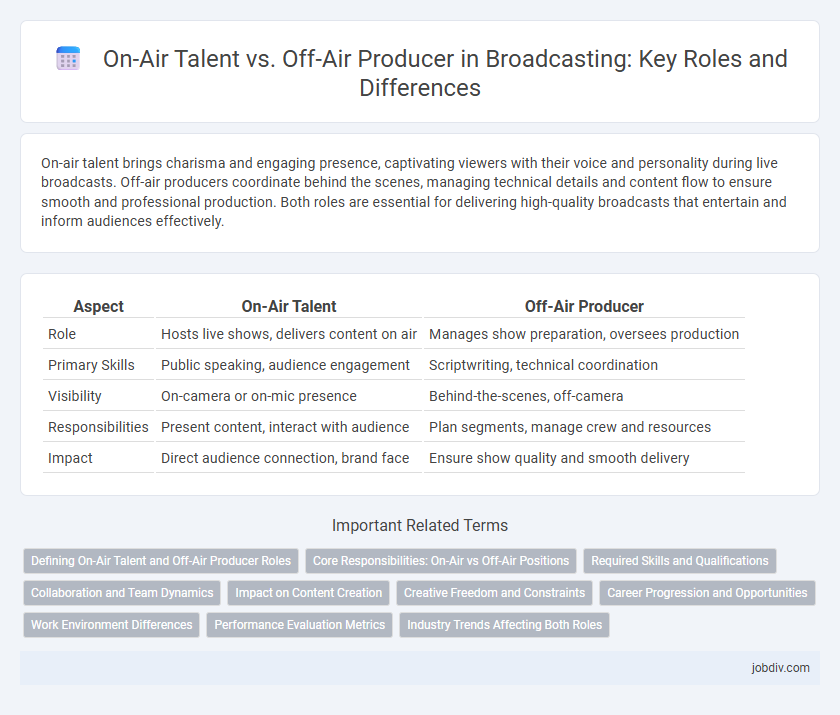On-air talent brings charisma and engaging presence, captivating viewers with their voice and personality during live broadcasts. Off-air producers coordinate behind the scenes, managing technical details and content flow to ensure smooth and professional production. Both roles are essential for delivering high-quality broadcasts that entertain and inform audiences effectively.
Table of Comparison
| Aspect | On-Air Talent | Off-Air Producer |
|---|---|---|
| Role | Hosts live shows, delivers content on air | Manages show preparation, oversees production |
| Primary Skills | Public speaking, audience engagement | Scriptwriting, technical coordination |
| Visibility | On-camera or on-mic presence | Behind-the-scenes, off-camera |
| Responsibilities | Present content, interact with audience | Plan segments, manage crew and resources |
| Impact | Direct audience connection, brand face | Ensure show quality and smooth delivery |
Defining On-Air Talent and Off-Air Producer Roles
On-air talent refers to the voices and faces directly engaging the audience during broadcasts, including anchors, hosts, and reporters responsible for delivering content live or recorded. Off-air producers manage the behind-the-scenes aspects such as coordinating segments, overseeing technical operations, and ensuring the smooth flow of the broadcast schedule. Both roles are essential in delivering a seamless viewer experience, with on-air talent focusing on presentation and off-air producers concentrating on production logistics.
Core Responsibilities: On-Air vs Off-Air Positions
On-air talent delivers live content directly to the audience, engaging viewers or listeners through voice, appearance, and personality across radio, television, or digital platforms. Off-air producers manage the production process, coordinating scripts, technical elements, and timing to ensure smooth broadcast execution behind the scenes. Their core responsibilities differ, with on-air talent focused on performance and audience connection, while off-air producers handle planning, editing, and logistics to support the broadcast's overall quality.
Required Skills and Qualifications
On-air talent requires strong communication skills, camera presence, and the ability to engage audiences with clear diction and charisma. Off-air producers need expertise in scriptwriting, audio-visual editing, and multitasking to coordinate seamless broadcasts and manage technical aspects. Both roles demand knowledge of broadcasting technology and teamwork but emphasize different skill sets essential for live production versus behind-the-scenes coordination.
Collaboration and Team Dynamics
On-air talent and off-air producers form a dynamic partnership essential for seamless broadcasting, where the producer manages content flow and technical coordination while the talent delivers engaging on-air performance. Effective collaboration relies on clear communication and mutual understanding of roles to adapt quickly during live shows, ensuring timely cues and smooth transitions. This synergy enhances overall production quality, audience engagement, and the station's brand consistency.
Impact on Content Creation
On-air talent directly influences audience engagement through charisma and delivery, shaping the emotional tone and accessibility of the broadcast. Off-air producers manage content strategy, scripting, and technical execution, ensuring coherence and quality behind the scenes. Their collaboration maximizes creative output, balancing spontaneous interaction with structured narrative flow to enhance overall content impact.
Creative Freedom and Constraints
On-air talent enjoys greater creative freedom by directly engaging with the audience and adapting content spontaneously during live broadcasts. Off-air producers operate under stricter constraints, managing technical logistics, schedules, and ensuring compliance with broadcasting standards. Both roles require collaboration, but the on-air talent's creativity is more visible, while producers shape the overall production behind the scenes.
Career Progression and Opportunities
On-air talent often gains visibility and public recognition, which can lead to opportunities in hosting, interviewing, and brand endorsements, enhancing career growth in front of the camera or microphone. Off-air producers develop crucial skills in content planning, team coordination, and technical operations, enabling progression into senior production roles or executive positions within broadcasting networks. Both roles offer distinct pathways; on-air talent excels in personal branding and audience connection, while off-air producers advance through strategic and managerial expertise.
Work Environment Differences
On-air talent operates within a live broadcast setting, engaging directly with the audience and managing real-time interactions, while off-air producers work behind the scenes coordinating technical logistics, content flow, and production schedules. The on-air environment demands quick decision-making under pressure, requiring clear communication and charisma, whereas off-air roles emphasize organizational skills, multitasking, and collaboration with various departments. Both roles are crucial to successful broadcasting but differ significantly in visibility, work dynamics, and stress factors.
Performance Evaluation Metrics
On-air talent performance evaluation metrics center on audience engagement, delivery clarity, and ability to maintain viewer interest, often measured through real-time feedback and ratings. Off-air producers are assessed based on content quality, technical coordination, and adherence to broadcast schedules, with metrics including error rates and production efficiency. Both roles require distinct yet complementary metrics to optimize overall broadcast performance and viewer satisfaction.
Industry Trends Affecting Both Roles
The broadcasting industry is increasingly valuing versatility as on-air talent adapts to digital platforms, engaging audiences through social media and podcasts, while off-air producers leverage data analytics and automation tools to optimize content creation and distribution. Emerging trends such as AI-driven content personalization and remote production workflows are reshaping the collaboration between on-air talent and producers, enhancing efficiency and audience interaction. Both roles face growing demands for multimedia skills and real-time audience engagement strategies to maintain relevance in an evolving media landscape.
On-Air Talent vs Off-Air Producer Infographic

 jobdiv.com
jobdiv.com